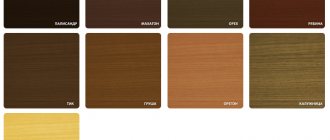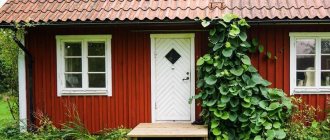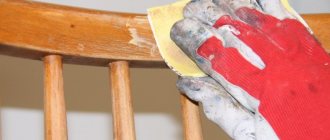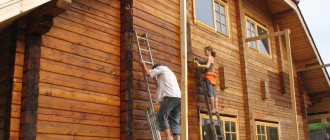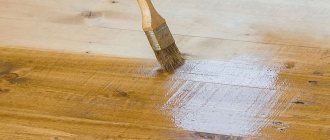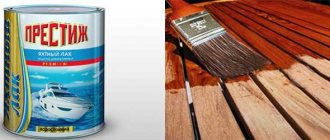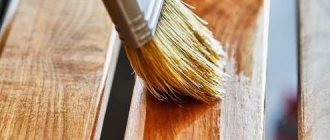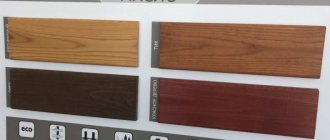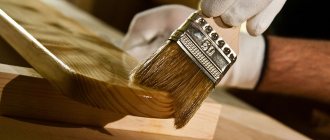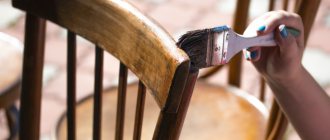Types of impregnations
If you decide to use wood for construction and decoration, you must protect it from external aggressive factors - moisture (snow, rain), because precipitation eventually saturates the wood, causing it to deform and dry out. Without protection, wood can rot, mold and fungus settle in it, which greatly reduces its service life and attractiveness.
For example, white fungus destroys even the strongest board in a matter of months. Without protection, pests often take up residence in wooden structures; moreover, parasites can be introduced with imported timber. The use of special means will help reduce the risk of fire, making the wood less flammable.
The lower part of the frame will be protected from moisture and fungus by the foundation and plinth - their installation does not allow the tree to come into contact with the ground. Installing enough vents and ducts will reduce the risk of moisture buildup. The upper part of the log house can be protected from the listed factors only by using impregnations.
There are several types of external wood preservatives. They can be divided into several large groups:
- penetrating (for interior work);
- film (for external);
- antiseptics;
- flame retardants (prevent easy ignition);
- complex impregnations with both antiseptic and fire retardant properties.
Another division - based on the main substance:
- Aquatic. They are universal, suitable for both exterior and interior use, and do not smell. They come in powder form and can also be found in crystalline form. Diluted with water according to instructions. They take a long time to dry and require pre-treatment of the wood with sandpaper and wetting before application. Do not use on dry wood.
- On solvents. They penetrate deeply into the wood structure, have a strong smell, and are toxic until completely dry. Ideal for external protection of wood from moisture, mold, and insects that have penetrated into the upper layers. Apply with a brush only. Available in various colors.
- In oil. Classic stains that we used all the time before. They penetrate deeply into the wood, protecting it from moisture and preventing cracking. Dirt and dust do not linger on such surfaces and are washed away by the first rain. Can be applied either with a brush or with a spray.
- Varnishes for outdoor use. A separate group of wood protection products. They not only protect well from various atmospheric phenomena, but also give a beautiful appearance.
- Acrylic. Protect wood from blackening and blueing, insects and mold. Acrylic compounds are used to impregnate wood – treated and untreated. They have high decorative value and are available in various colors. Suitable not only for external, but also for internal work. Dries within a few hours.
- Wax or wax/oil impregnations. After using them, it is impossible to apply any other impregnations. Therefore, when choosing this option, you need to think several times.
Thus, penetrating compounds on various bases are preferred for outdoor work. It is worth mentioning tinting impregnations. In addition to protecting against moisture, mold and mildew, they give the surface of the wood a beautiful color, emphasizing the texture of the wood.
In addition to heat-resistant impregnating compounds, there are various types of fire-retardant paints for wood.
Interesting thematic VIDEO:
Wood rot is a serious problem. The damage caused by these biodestructive processes cannot be restored; the lost strength characteristics cannot be returned. Therefore, it is not worth experimenting or looking for inexpensive products from unknown manufacturers, because at this time the wooden material will continue to deteriorate. It’s better to turn to Neomid for help at the first signs of mold or rot; their compositions will quickly and effectively eliminate an unpleasant and dangerous problem.
Purposes of using impregnations for outdoor work
Most impregnations are intended to protect wood from damage and destruction, and to improve decorative properties. Main types of impregnations and their purpose:
- Anti-darkening. The reason wood becomes darker over time is due to fungal infiltration. High-quality impregnation will prevent fungus and therefore eliminate darkening of the material. Different products protect wood for different periods of time, which can vary from 3 months to several years. Typically, more expensive impregnations work for a long time, since they are practically not washed out of the base. Some products simply mask the problem, while others act in a targeted manner, destroying microorganisms. It is undesirable to use impregnations with chlorine - the compositions burn and destroy the wood. Oxygen in solution works much better, without having a negative effect on the base and making the wood lighter.
- Against moisture, rotting. Impregnations with water-repellent properties are suitable in almost any situation. The compounds penetrate the wood, preventing it from deforming, rotting, or cracking. After applying the product, moisture will not penetrate into the deep layers of the material, air exchange is optimized. Most products contain UV filters that prevent the material from fading, which only improves its performance. The impregnation layer will have to be renewed every 1 to 3 years or as indicated on the label.
- Anti-flammability. Impregnations with bioprotection and fire protection “two in one” are no less popular. They come in coating form (varnishes, pastes that change color but do not penetrate the structure) or in the form of compositions (impregnations that optimize the texture of wood).
- For important, load-bearing bases. It is recommended to use such products to cover load-bearing walls and other important elements that need to be more reliably protected from damage by fungus, insects, groundwater and precipitation. These impregnations have the property of not being washed out for years, and are supplemented with powerful antiseptic and fungicidal properties. More expensive products do not change color, but cheaper ones can turn the wood greenish.
There are decorative impregnations that are water-based and contain acrylates, which prevent the wood from changing its tone and protect against UV rays. The colors of the impregnations are varied, which allows you to change the main color of the wood in accordance with the chosen style.
Why does a wooden house rot?
Rot is the final stage of mold development. Several reasons contribute to its appearance:
- The foundation is not waterproofed. This is especially true for regions with high groundwater level, periodic or constant flooding during spring floods.
- Raw lumber. Experts recommend using boards and timber with a moisture content of no higher than 12%. For only a felled tree this figure is at the level of 40%. Under natural conditions, drying takes at least a year. At sawmills, special furnaces are installed to speed up the process. They are additionally treated with antiseptics.
- Incorrect backing board selected. It separates the base from the lower crowns. The best material for this purpose is larch. Boards made from other types of wood will not prevent walls and floors from getting wet.
- Incorrect indoor microclimate. The rooms are practically not ventilated. In a house made of timber or logs, laundry is dried after washing. The owners love to take a hot shower, but did not take care of steam removal and high-quality ventilation.
- There are no vents in the cellar. If they exist, pits are not equipped. Rain or groundwater gets inside, shortening the life of the building.
- The roof overhang is less than the recommended values. Precipitation flows down the walls and onto the foundation. The situation gets worse if there are no blind areas.
- The lower crowns are made of low-quality material, are not impregnated with antiseptics at the preparation stage, or are located closer than 30 cm to the ground.
- The roof has not been waterproofed and the roof joints have not been sealed. They were not caulked, filled with tow, jute, or insulated.
Any of the above reasons, or even more so a combination of them, will lead to rotting of the house. How to stop this process will be discussed further.
Selection rules
Wood protection compositions can be unidirectional or complex. The first protect against one thing: from moisture (water-repellent) or from rot, mold, bugs (antiseptic), or prevent fire (fire retardant). The latter act comprehensively in three directions: they prevent rotting, repel moisture, and prevent the wood from catching fire in case of accidental contact with a fire source.
Rules for choosing impregnations:
- Decide what you need to protect the tree from. Complex impregnations are more expensive, but they save time and physical effort. Unidirectional compositions can be applied one at a time, but you will have to spend three times as much time and effort on this. Plus you need to remember that usually one layer is not enough.
- Think about how important the appearance of the tree (house) is to you. You may need compositions that can be tinted, or they are available in a range of colors.
- Evaluate the scope of work so that you can buy as much impregnation at the construction market as you need, do not forget about a small supply. This is especially important if the composition is tinted.
- Do not buy impregnations on the construction market. This is due not only to the possible lack of a certificate for the goods from sellers, but also to unsuitable storage conditions. Impregnations should not be stored at sub-zero or too high temperatures.
- Having chosen a product, read the instructions for it. It always indicates how long the wood will be protected. Look only at the first number. Any composition with color in direct sunlight will fade within 3 to 5 years. Therefore, there is no point in spending money on expensive products that promise color preservation for 10 years or more. This is nothing more than a marketing ploy and price increase.
- Don’t forget to check with the seller how the impregnation is applied; perhaps the best solution would be to purchase an inexpensive spray gun. This will save a little on the composition and ensure even application without drips.
Important! Always wear a respirator when working. Even the safest environmentally friendly impregnations contain benzene. Inhaling it is harmful even in microscopic quantities. Oil and alkyd compounds are especially harmful to humans.
Interesting thematic VIDEO:
When choosing an antiseptic, it is also necessary to pay attention to the manufacturers, especially if you plan to carry out the treatment inside the living room. The company must be popular, proven, well-known and have a good reputation. For example, such is the Russian company Neomid. They have a lot of positive reviews and many recommendations. They specialize in the production of protective products for wooden products and structures made of wood. The high quality of their products pleases and at the same time pleasantly surprises.
Manufacturers
The impregnation market is diverse. The compositions are produced by both domestic and foreign manufacturers. To have an idea, you need to familiarize yourself with the most famous brands:
- "LuxDecor Plus". A high-quality product of the European level - water-soluble wood impregnation LuxDecor Plus has appeared on the Russian market as an affordable means of combating several aggressive weather factors at once. It is not afraid of wind, rain and snowfall, and it is these conditions that most often cause damage to wood. Impregnation also protects against rodents and fungus for a period of at least 3 years after treatment. Acrylic impregnation can be applied both outside and indoors; due to the absence of alkyd resins and solvents, it is completely safe for the environment and people living in the house. Suitable for decorating children's toys and furniture, it is odorless and contains wax. It has a gel consistency, which greatly facilitates application and also reduces processing time. It does not flow even when painting the ceiling and provides a matte, silky layer (when applied in two layers), which can reliably protect the wooden surface from rot and mold for the specified service life.
- "Mokke Foressa". A composition for the protection and decoration of wood based on alkyd resins Mokke Foressa increases the resistance of the treated wood to UV rays, seasonal temperature changes, light mechanical damage, mold and insects. When applied in three layers, the surface treated with Mokke Foressa acquires the delicate shine and decorative effect of expensive wood species for up to seven years. The impregnation forms a moisture-resistant film thanks to the microwax in the composition, which increases the water-repellent properties of the wood (compared to an untreated surface). For interior and exterior use.
- "Belinka". A Slovenian brand that produces penetrating protective primers, azure thick-layer impregnations with wax, decorative azure, deep-penetrating impregnations, colorless liquid antiseptics.
- "Pinotex". Dutch company. It produces several types of wood preservatives, including yacht alkyd-urethane varnish with a high degree of wear resistance.
- "Senezh". Domestic. It produces all types of impregnations for wood and decking boards: antiseptics, biopyrenes, preservation solutions and protective compounds for thrifty owners. The assortment includes tinted
- "North". Also a domestic manufacturer. It produces professional wood protective products that are in no way inferior to foreign ones. It produces biopyrenes, fire-retardant impregnations, and antiseptics not only for wood, but also for other types of substrates.
- "Dufa". German manufacturer. It produces several types of wood protectants with and without wax, including colorless antiseptics that protect against mold, blue stains, and moisture.
- "Tikkurila". A Finnish concern that produces a great variety of paints and varnishes, including protective compounds for wood – the “Valtti” line. Antiseptic "Euro Eko Wood" from "Tikkurila" can be tinted in the desired color. It perfectly protects wood outdoors from mold, rot and moisture.
- "Aquatex". Domestic manufacturer. It produces several types of combined formulations (antiseptic + moisture protection + UV filter), biopyrene protection is not presented. There are products based on wax and oil (“Aquatex Extra”), decorative ones with protective functions (“Aquatex”), and a non-washable antiseptic (“Aquatex primer antiseptic”).
- "Neomid". Russian manufacturer of the best fire protection for wood and decking boards. Neomid 450 is a preservative and belongs to class 1 (4 layers of coating) and class 2 of fire protection efficiency (GOST 53292-2009). The composition, in addition to fire retardants, includes an antiseptic and a tinting pigment to control the quality of processing. The antiseptic effect lasts up to 10 years, the fire retardant effect lasts up to 7 years.
- "KSD" is a Russian remedy. Belongs to the class of preservatives and effectively protects wood outdoors and indoors from rotting and fire (class 2 protection according to GOST 53292-2009). There are no dyes in the composition, so you need to work extremely clearly, without missing a single millimeter. “KSD” is able to stop the rotting process that has already begun and destroy mold. Corrosive activity when treated wood comes into contact with metal is low. The composition does not smell of anything, protects wood from fire for 4 years, from biological processes - 5 years. It is one of the best wood protectants.
- "MÖKKE antiseptic." MÖKKE permanent antiseptic guarantees long-term protection of wood against mold, mildew, insects and fire hazards. The newest wood protection product was created taking into account all the features of the changeable Russian climate and using the latest Finnish technologies. This combination guarantees the buyer a high-quality preservative composition to protect wood for a period of more than 55 years at a price significantly lower than foreign analogues. The new generation antiseptic contains polymer dispersions, pigments, waxes and special additives, which together make it possible to use it to protect terraces, foundations, gazebos and any wooden structures and products, even in the case of prolonged contact of the treated surface with water and soil. The European quality product can be used as a primary coating before painting with varnishes and paints, or perform an enhanced protective function when processing wood yourself. Suitable for application by brush, roller or spray gun.
Advice! Before purchasing, take a look at the website of the selected manufacturer, study the range of impregnations and their properties, and pay attention to the cost. Then make an estimate, calculating everything down to the smallest detail. Only after this go to the store to buy the material.
What wood to choose for building a cottage
When making a choice in favor of one material or another, one must take into account not only its external beauty and ease of processing, but also its species and resistance to putrefactive processes.
Coniferous wood
It is especially popular in Siberia, the Far East, and the north of the European part of Russia. In the south, pine and spruce trees practically do not grow, which significantly limits their use in individual housing construction.
The most popular are:
- pine. The tree does not require special storage conditions. Has increased strength and resistance to rot;
- spruce. Without special regular treatment, it will not withstand constant contact with atmospheric moisture and various bugs. The result is rapid rotting and decomposition;
- fir. Features soft wood. If you do not treat it with antiseptics in a timely manner, the fir beam will become covered with mold even before the foundation pit is prepared;
- cedar. Resistant to rotting, including when used in conditions of constant high humidity;
- larch. It has a very dense structure into which water does not penetrate.
Hardwood
There are also options recommended for construction and those that are best left at the sawmill:
- oak. Does not crack or warp. If a log remains in water for a long time, it will only become stronger;
- birch. This tree is characterized by medium density combined with high strength. But this does not get rid of decay;
- aspen. It has a soft structure that is not susceptible to rotting. Aspen is rarely used for exterior decoration, but there is a place for it in a bathhouse or sauna;
- ash. In terms of strength characteristics and resistance to rotting, it is not much inferior to oak;
- poplar. It is generally not recommended to be used as a building material. It warps quickly, and the boards become covered with cracks after drying;
- Linden. It has soft wood that does not require much effort when processing. But buildings are almost never built entirely from it. Most often used for finishing steam rooms.
If you decide to buy a house made of 6 by 9 timber according to the given characteristics, you should prefer oak, ash, larch or cedar. But these breeds are expensive and not accessible to everyone.
Another significant moment! Trees grown in northern conditions are more resistant to freezing and unfavorable external conditions. Their wood is denser. Trees growing in the south are often weaker. Without periodic treatment, they will not withstand exposure to moisture or woodworms.
Houses made of timber
from RUB 325,000
Frame houses
from RUB 283,000
Country houses
from RUB 266,000
DIY antiseptic
There are many recipes for homemade mixtures that protect wood from rotting and being eaten by wood-boring beetles. The main composition proposed is bitumen mixed with kerosene. However, such protection is relevant only for buried wooden parts, for example, fence posts or the lower crowns of a log house. It is impossible to imagine a wooden house coated with such a hellish, in terms of appearance, mixture.
Wax-based wood impregnation not only does not spoil the appearance of the wood and has good water-repellent properties, but also protects against annoying insects. Anyone can handle its preparation:
- Prepare the ingredients - wax and turpentine, you can add rosin. Wax/turpentine ratio – 2/1, wax, turpentine, rosin – 100/50/25.
- Heat the wax in a water bath, then remove from the heat, add turpentine to it. Mix thoroughly until you obtain a homogeneous paste.
- The second option is to heat the wax in a water bath and add rosin. After dissolving, rub thoroughly and add turpentine in a thin stream. If you want a pleasant scent, add lavender or peppermint oil.
Important! You can coat railings, platbands, carved elements and the entire outer surface of the log house with this composition. Further painting can be done with oil paints.
Both types of homemade impregnations have the following positive qualities:
- can be used not only for external work, but also for internal work;
- have a pleasant persistent smell;
- have good resistance to mechanical damage;
- consist of environmentally friendly materials;
- repel water well, protect against rot, mold, insects;
- improve the appearance of wood, make its texture clear;
- do not peel off in the sun;
- dry quickly (no more than 7 hours).
Preparing the surface for processing
Clean, dust-free surfaces should be treated with penetrating impregnations. If the wood has previously been coated with varnishes, paints or other impregnations whose composition is unknown to you, you will have to completely clean the surface of them before applying the protective composition. Use various hard brushes, scrapers and a heat gun for this if you cannot remove the paint by other means. Additionally, sand the surface to make it smooth, then remove dust.
Prepare the impregnation according to the instructions and apply it to the surface of the wood. Depending on the composition, each subsequent layer is applied either on a completely dry or still wet previous one. Impregnations without tinting can be painted after drying.
Protection of wood from fire and weather conditions must be carried out at the construction stage. Treating a finished house is quite difficult. It will not be possible to qualitatively protect all parts of a fully erected structure, which means that the risk of wood destruction from penetration of moisture and insects into unprotected areas increases.
How to speed up the process of wood decay
Sometimes the susceptibility of wood to rot can be regarded as a positive thing. If you know how to accelerate decay, you can use this feature of natural material to your advantage and force the fall of a tree or the removal of a stump.
Tips to speed up decay to remove dead trees and stumps are:
- Drill more holes in them a couple of centimeters deep. Insects will gather in these crevices, and moisture will accumulate during rainfall. Thus, the decay of the cellulose will accelerate, and the wood will decay much faster.
- You can speed up decay by sprinkling spores or pieces of mushrooms taken from already rotten wood of the same type onto a tree or stump.
- Water the soil around the unwanted trunk with nitrogenous fertilizers, which will provoke the development of parasitic fungi. After some time, you can feed the fungi with sweet water to stimulate the growth of their population.
All of these tips can be used at the same time. And, of course, you should water the trees more often and moisten the stumps. Then favorable results will not take too long to arrive.
